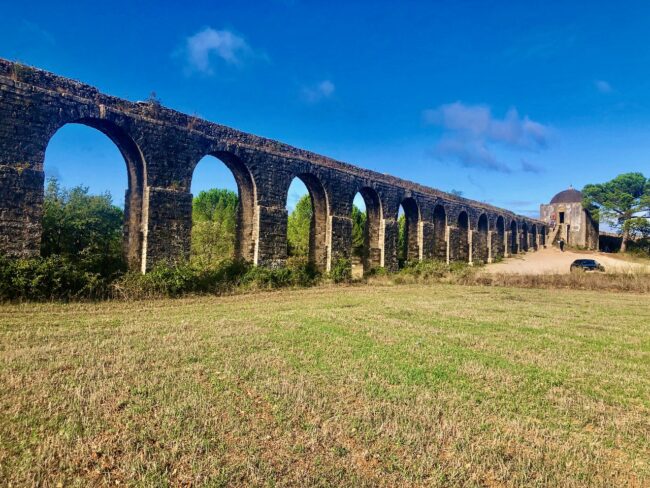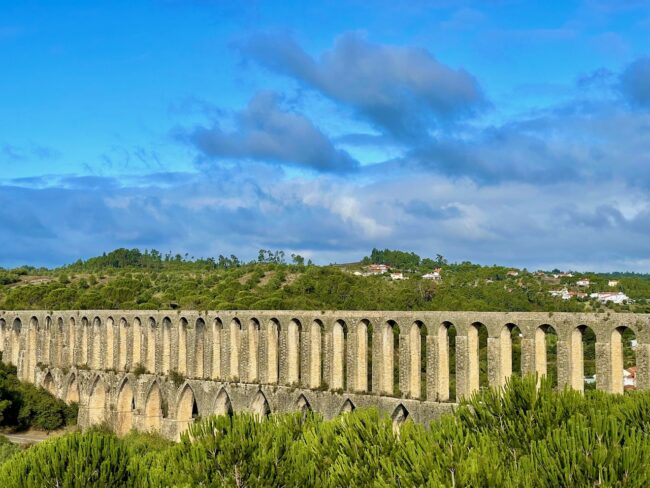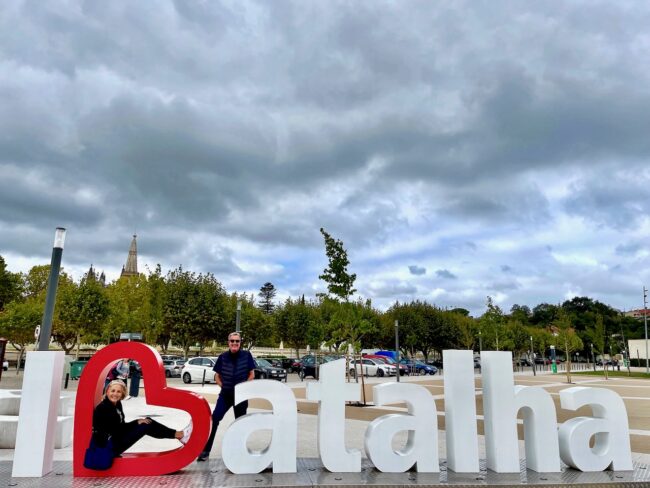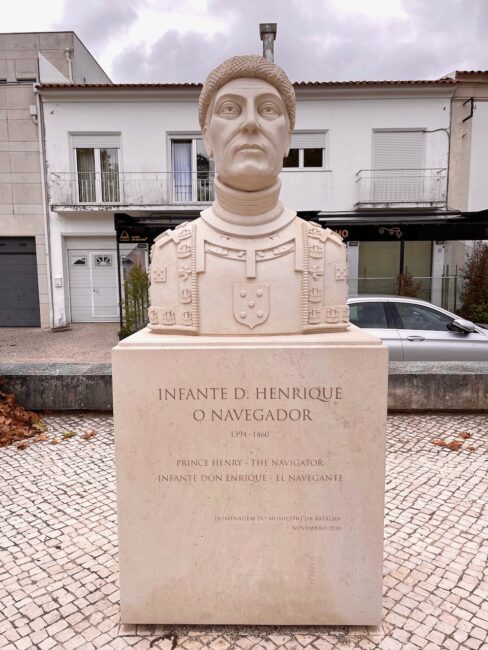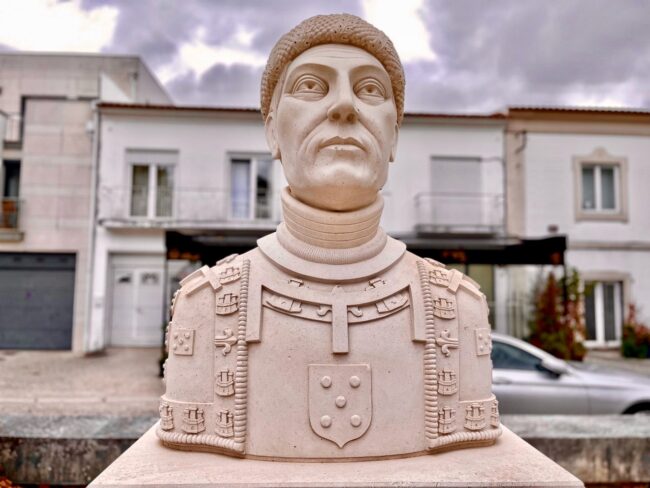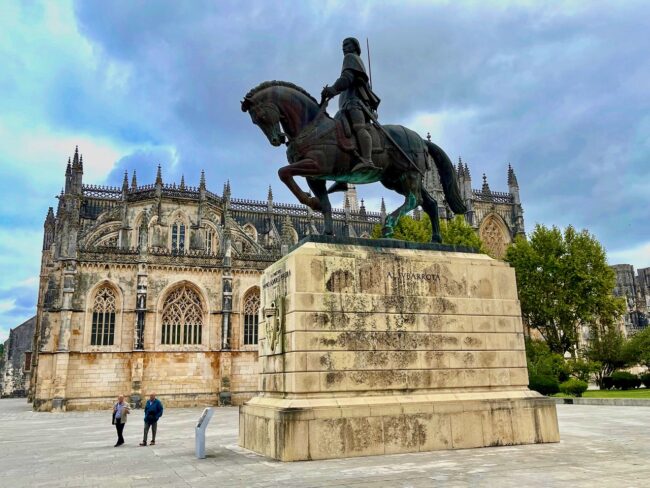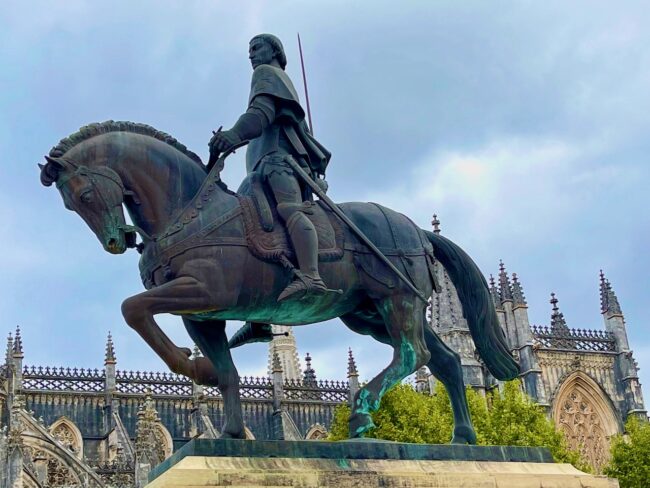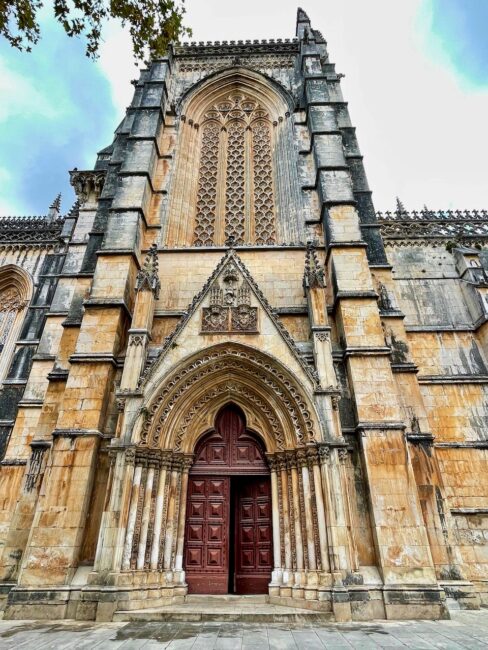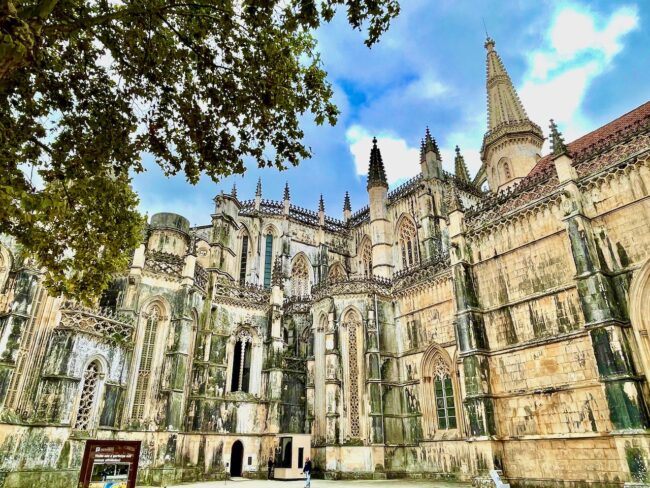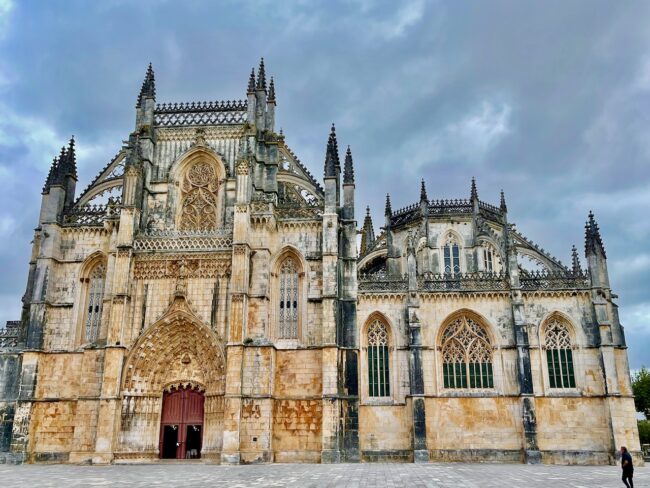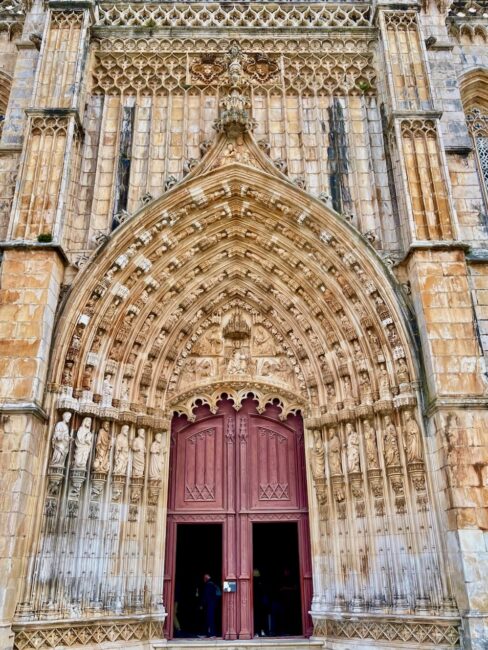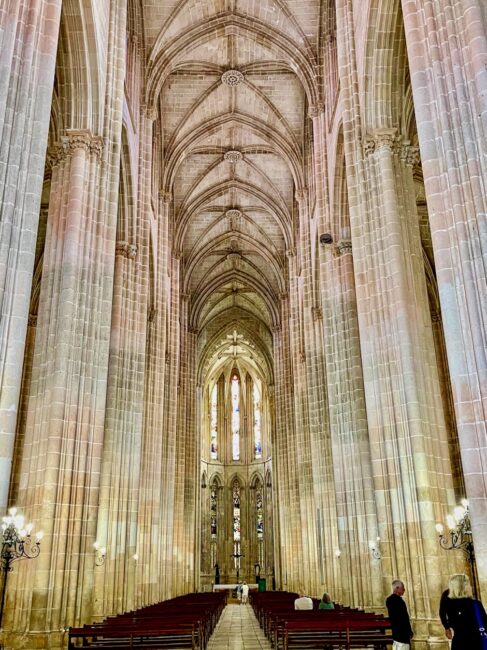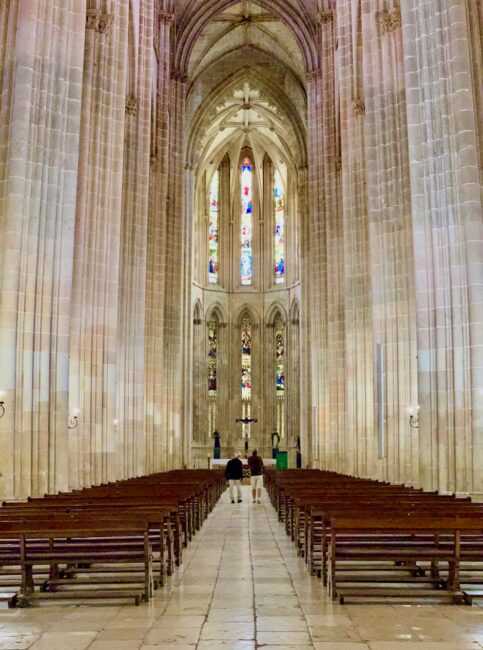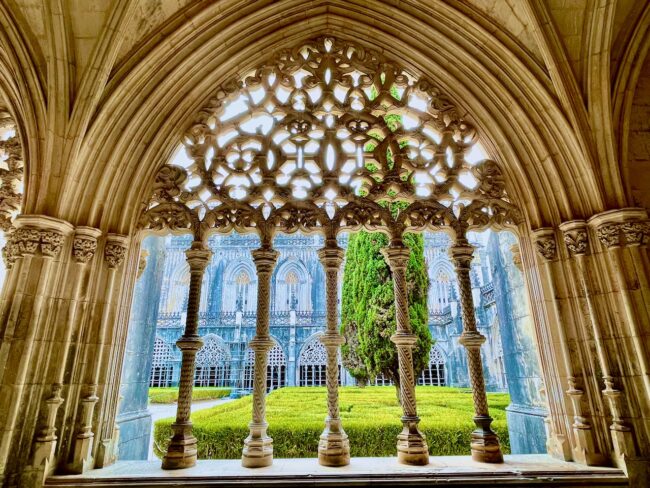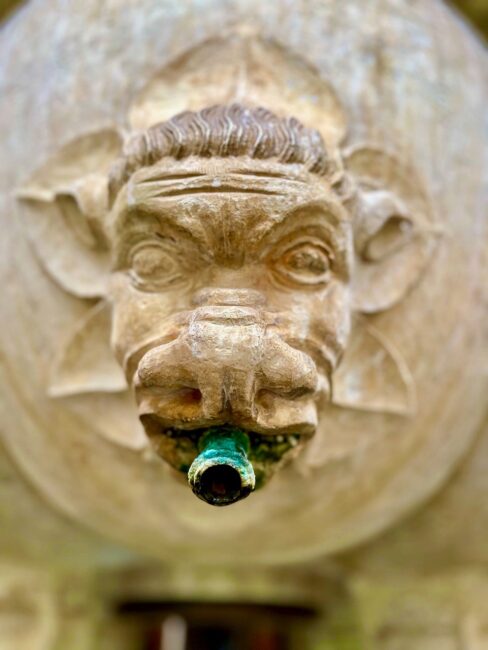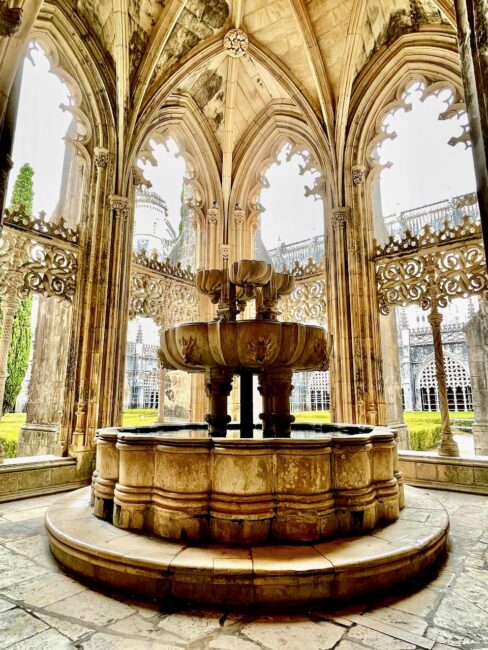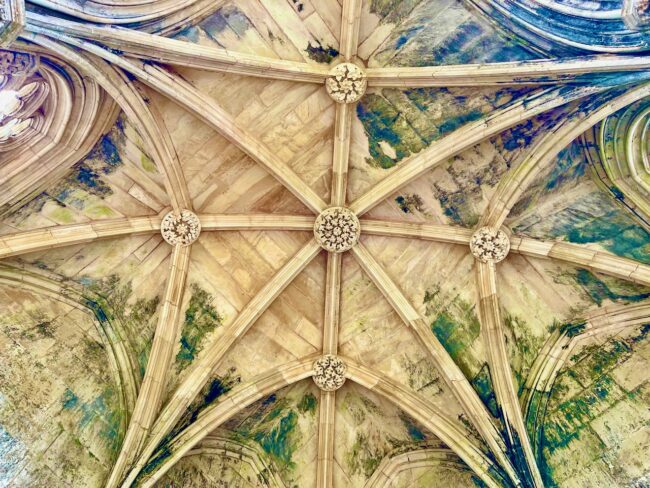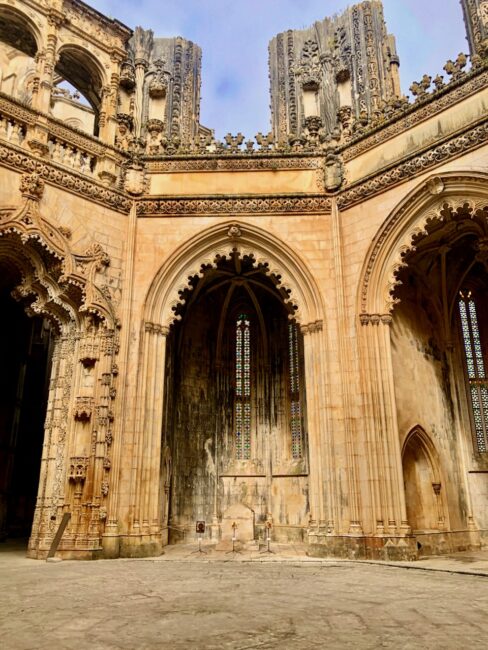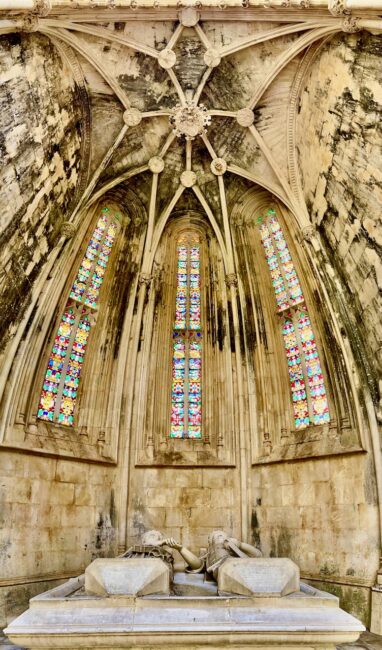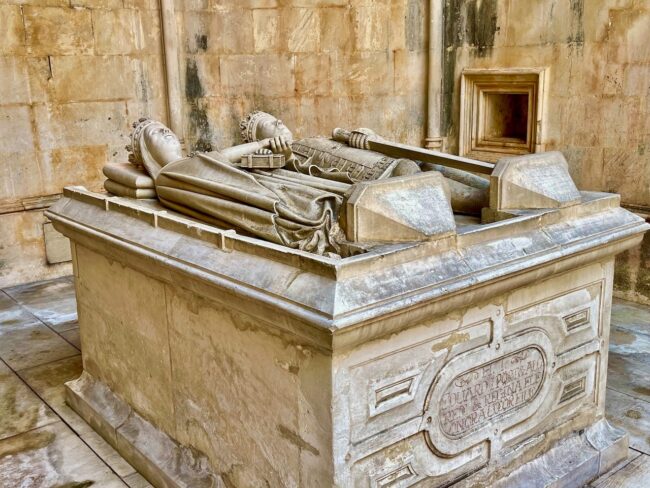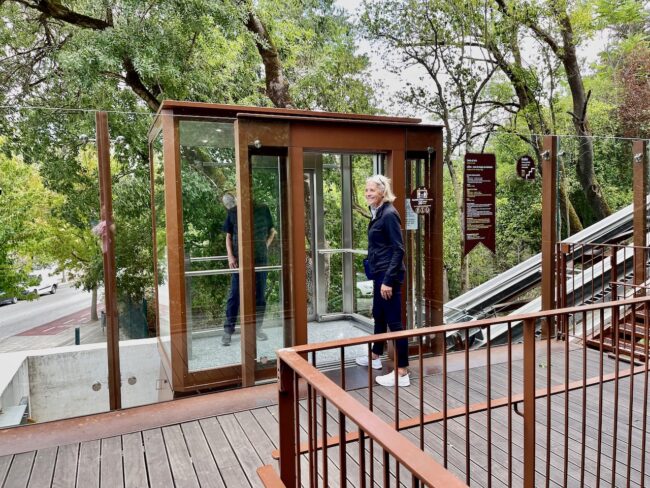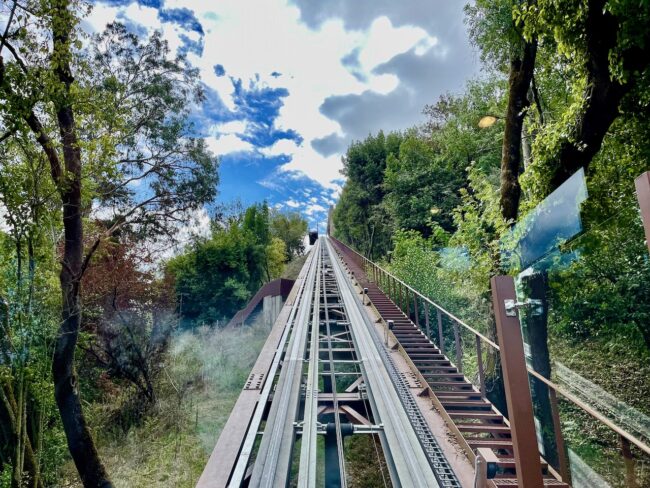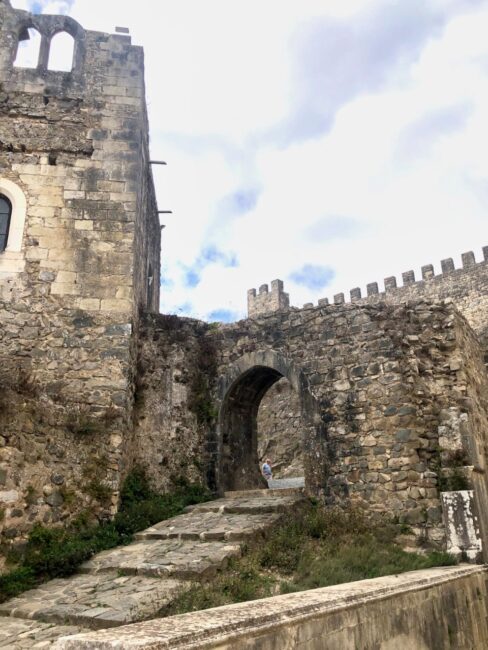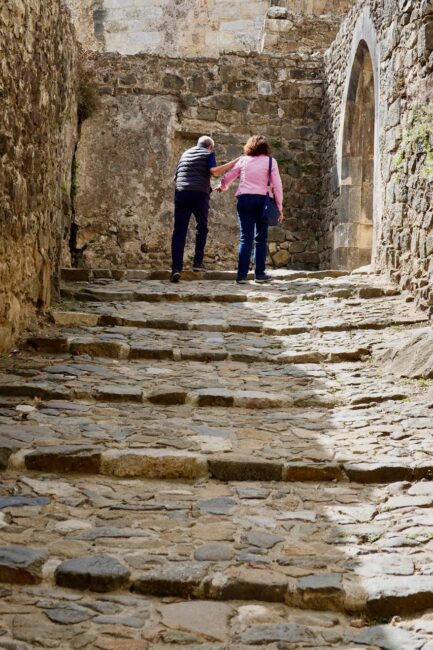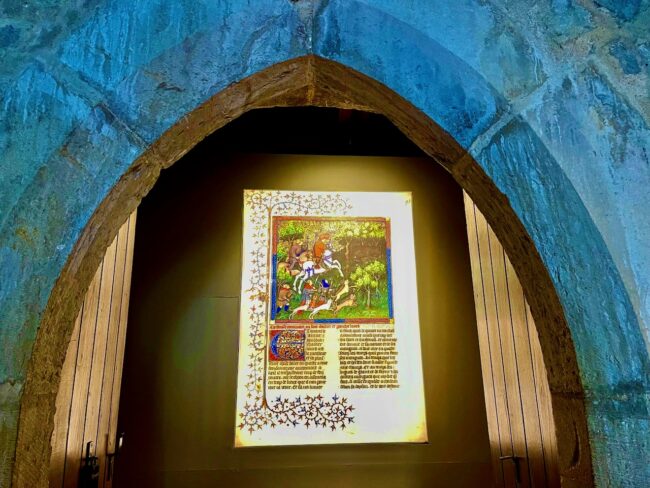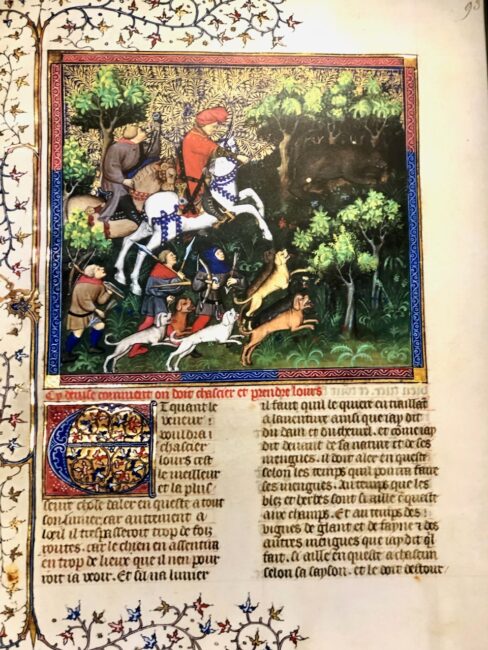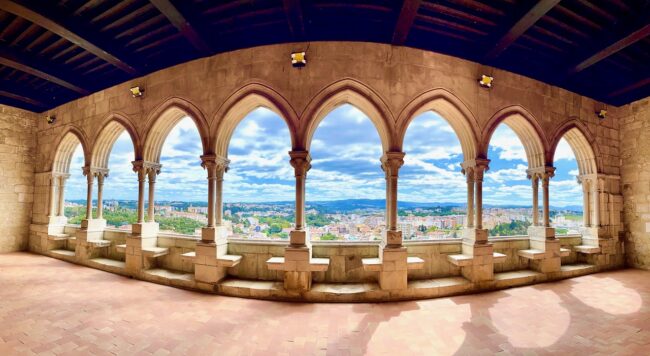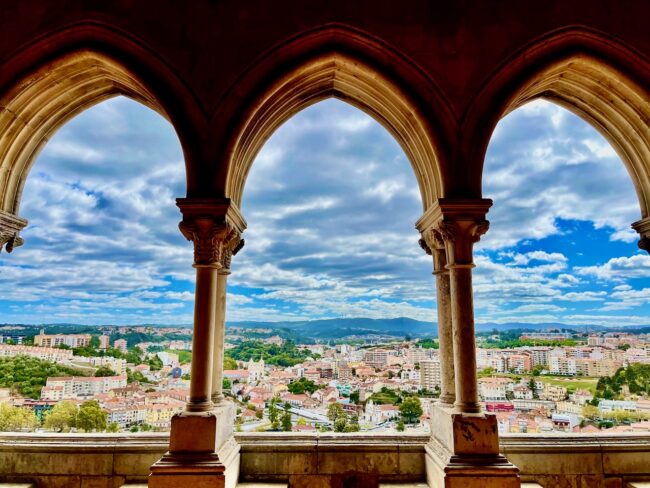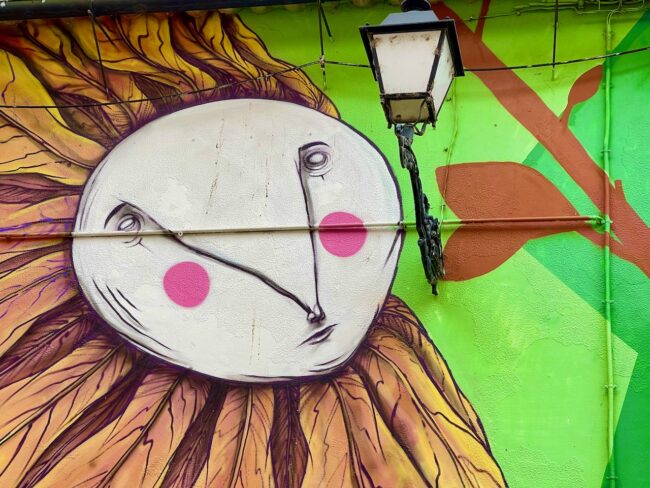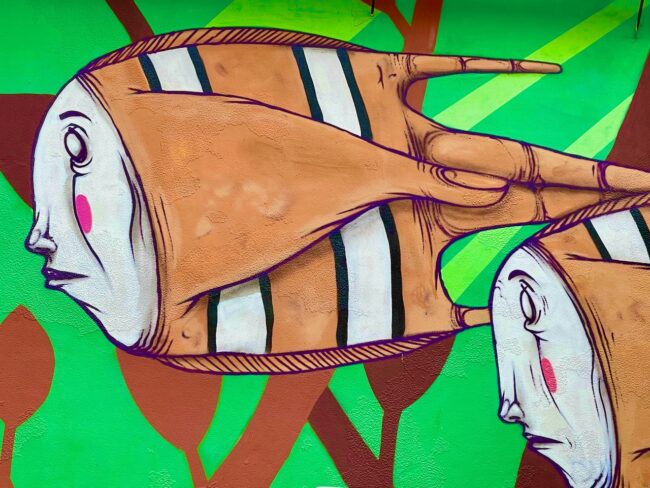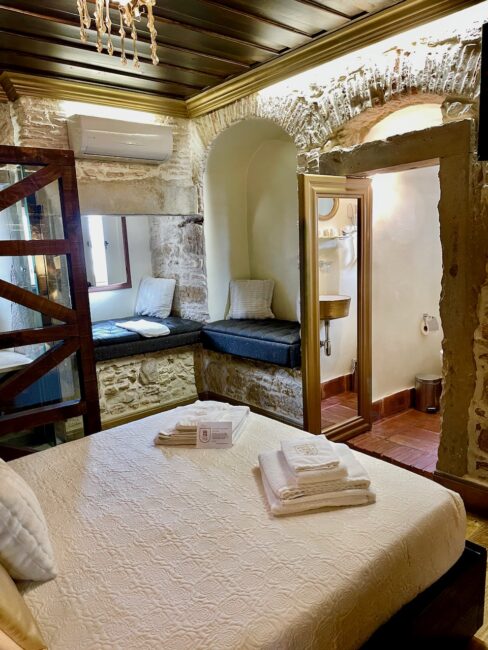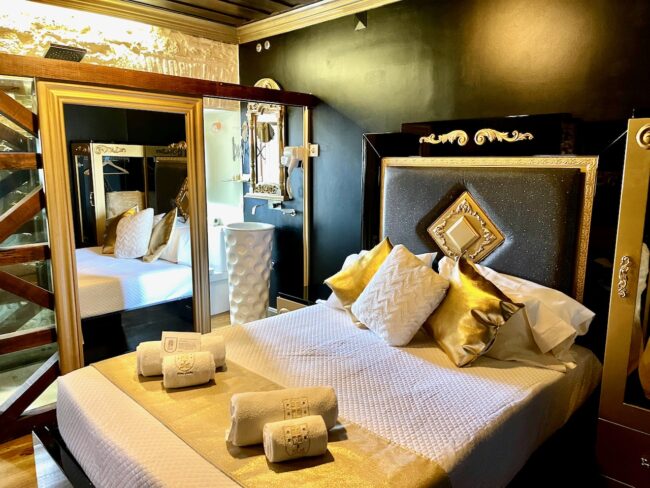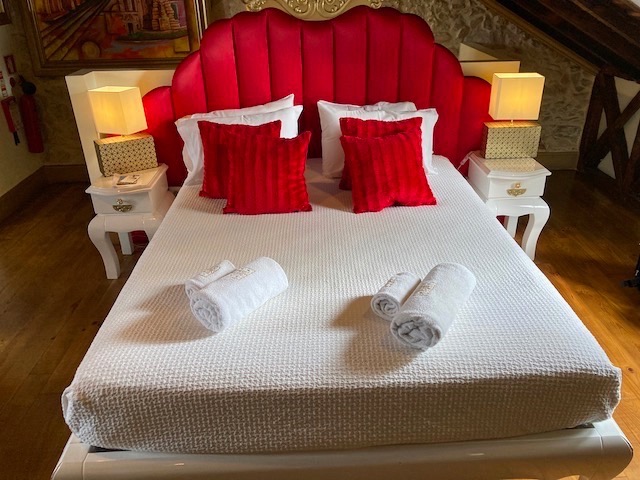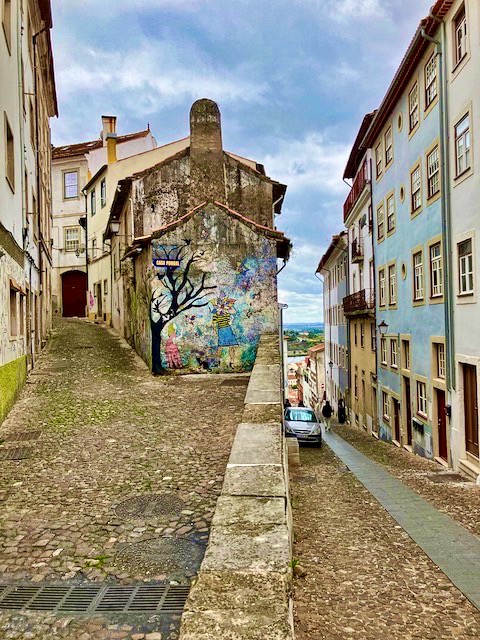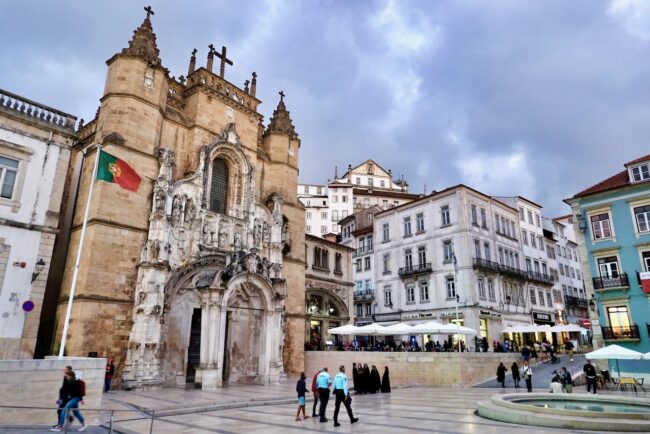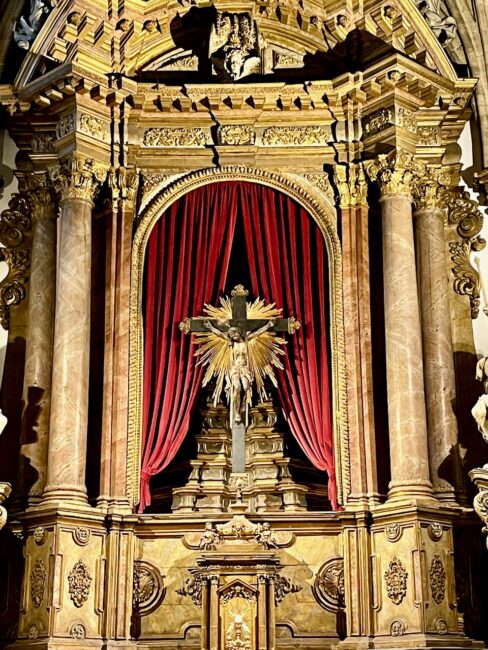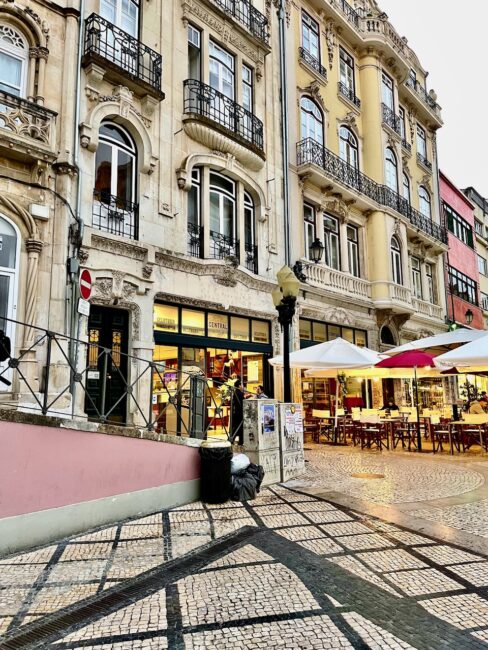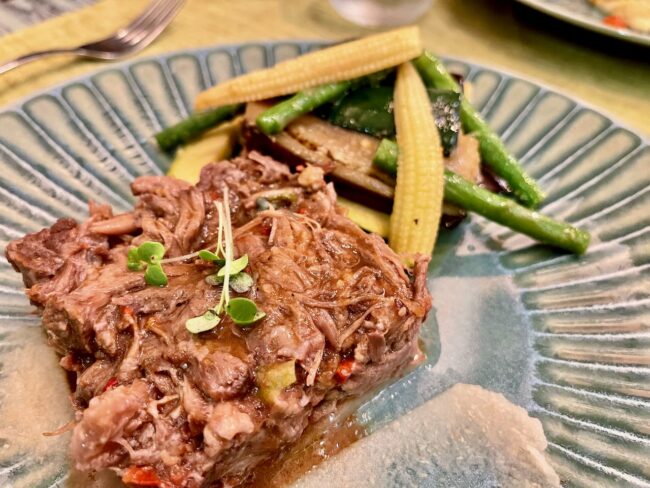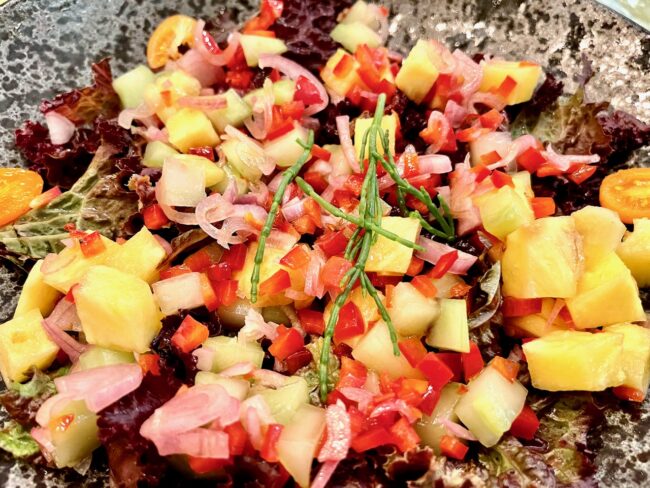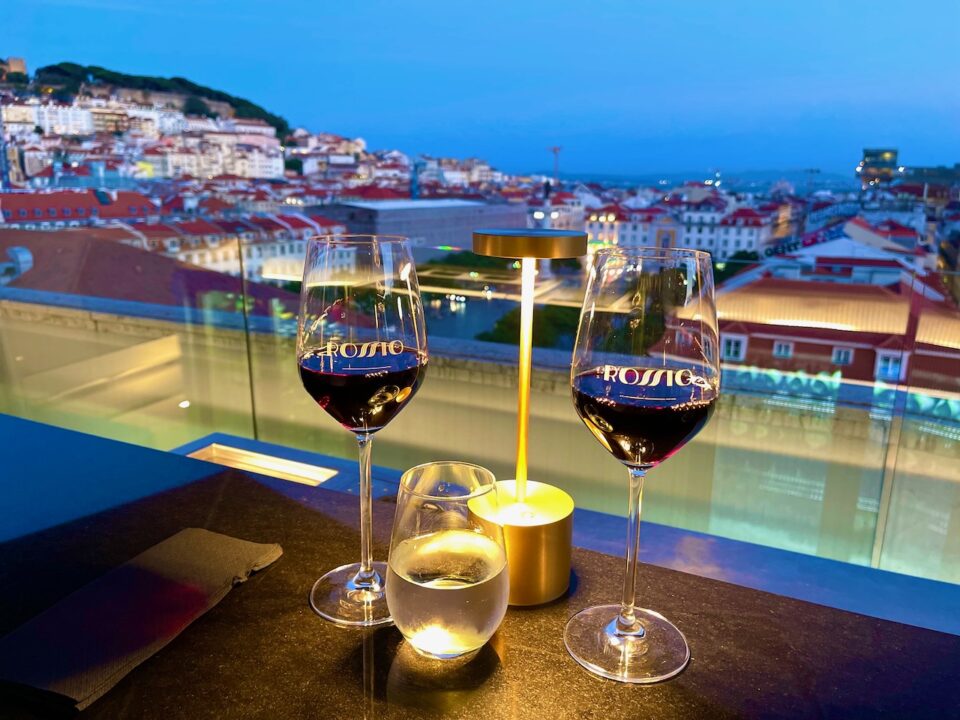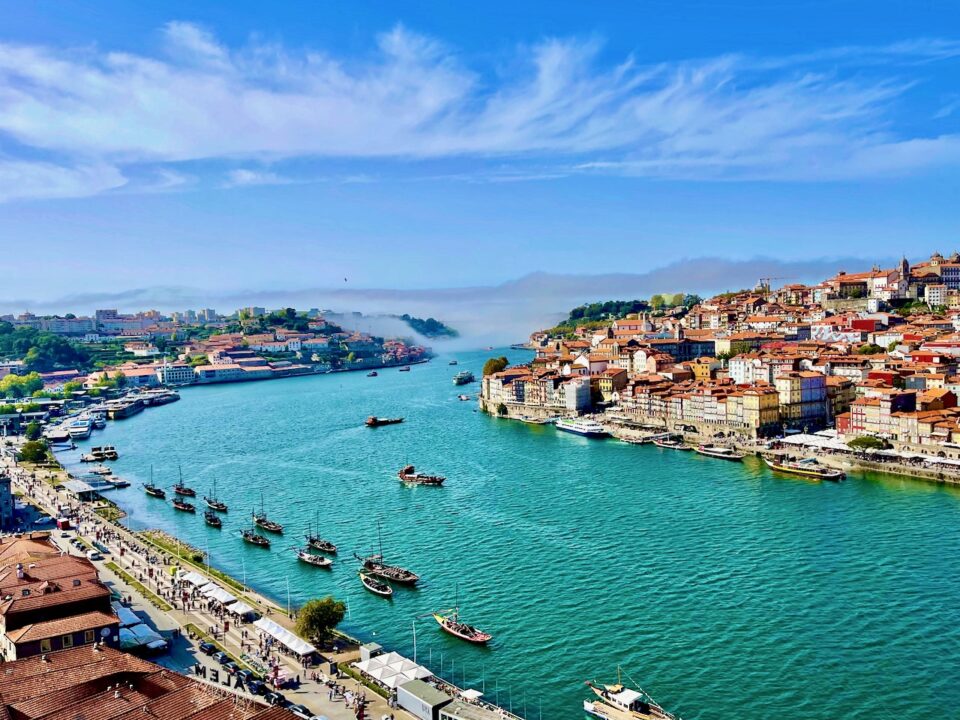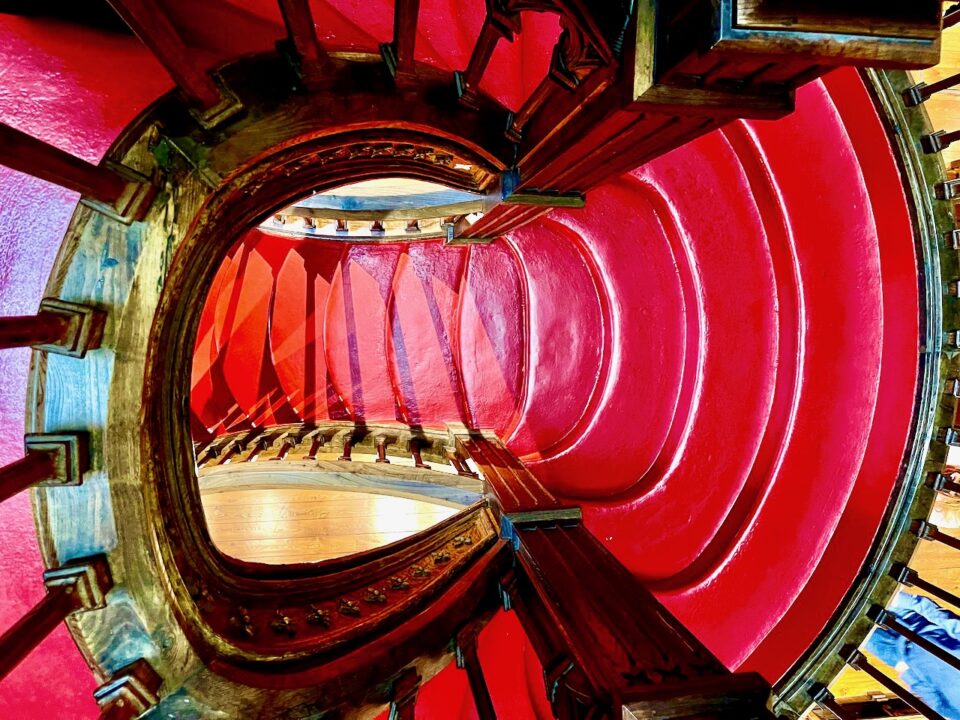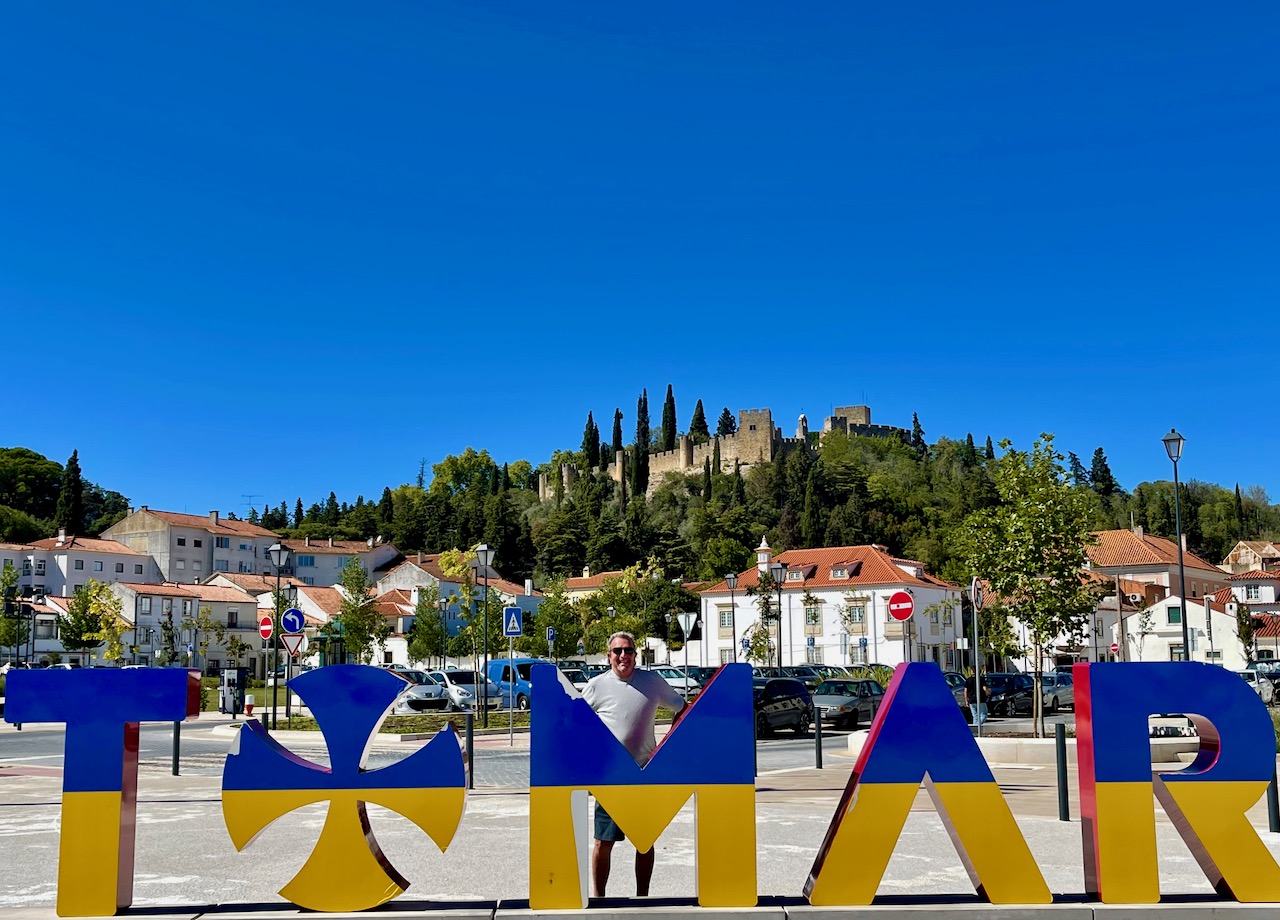
Chapter Eleven: Traversing Templar Tomar
January 27, 2023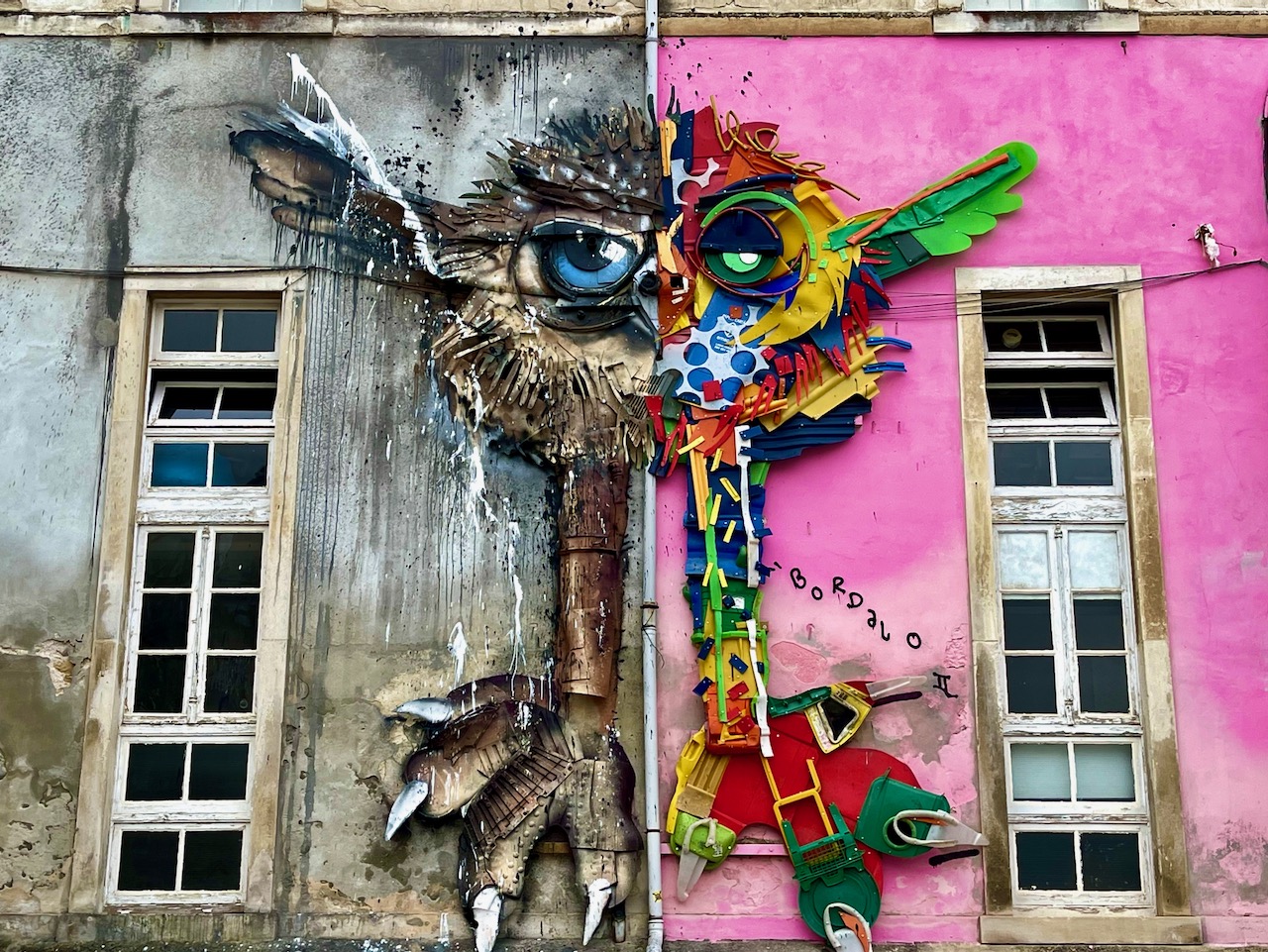
Chapter Thirteen: Combing Coimbra
February 10, 2023Falling For Portugal: A Mai Tai Tom “Trip” Report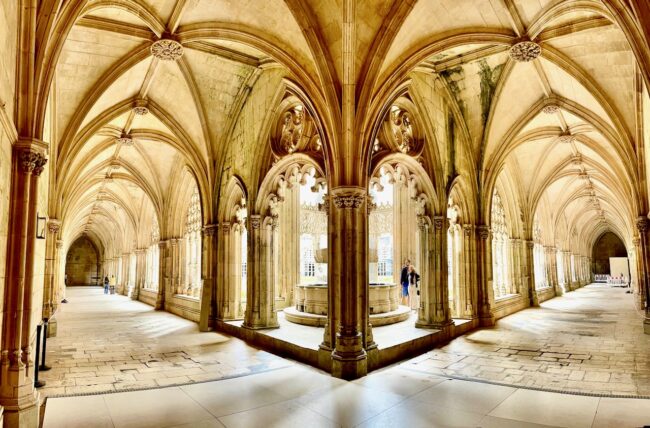
Chapter Twelve: Tomar To Coimbra
Day Twelve: Arch Supports, Skipping “Our Lady,” Massive Magnificent Monastery, In Search Of Henry, Sky Ceiling, Stadium Parking, Fit For A King, Trash Talking, Rental Car Peril, A Quirky Fun Hotel, Cape Town and Singing The Night Away
Our short stay in Tomar had come to an end. Tomar was perfect for a two night stay and there was plenty to do. Despite the construction going on next door, we recommend the Thomar Boutique Hotel as a quality place to stay. Now, it was on to Coimbra.
It was just five minutes to our first destination of the day, Aqueduto dos Pegões Altos (aka O Aqueduto do Convento de Cristo).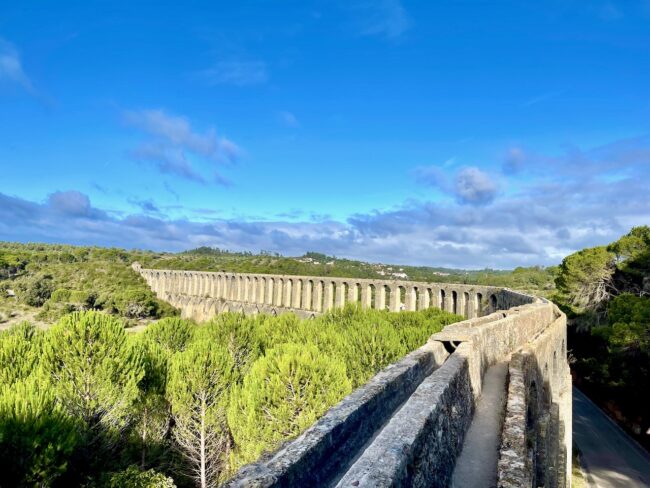
Stretching for about six kilometers across the Ribeira dos Pegões Valley, the aqueduct was constructed to supply water to Convento di Cristo and Tomar. It did so until the middle of the 20th century.
Construction began in 1593 under direction of Filippo Terzi, who had the cool moniker of “Chief Architect of the Kingdom.” Take that Frank Gehry.
There are a lot of good vantage points to take in this marvel that brought water to the convent from four springs. The aqueduct has 178 more arches than McDonald’s, 180 in all. The highest of them rises nearly 100 feet.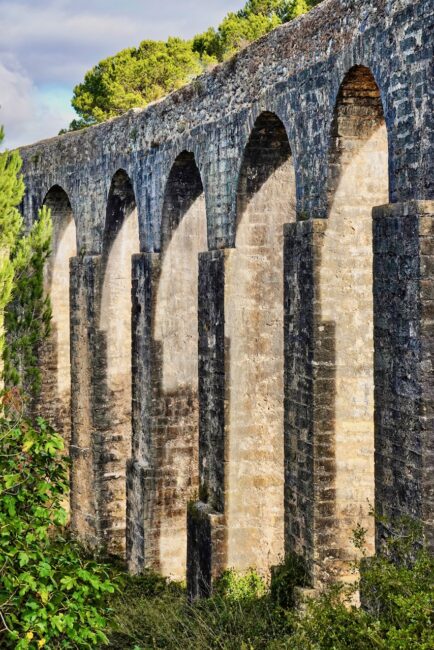
For the brave and those willing to risk death, there are sections of the aqueduct that you can walk on. In actuality, speaking from my ground level point of view, it’s not too bad if you have balance, so only Tracy and Kim went up onto the aqueduct. This building is the entrance to the top of the aqueduct.
We spent about 20-30 minutes hanging around. It was a great way to start the day.
A half-hour later we reached the gorgeous Gothic (along with Manueline) style Mosteiro da Batalha (Moistero Santa Maria da Vitória), the final stop on our Heritage Trifecta Ticket. Don’t skip this mosterio, it is magnificent! Founded by King João I in 1386, although construction continued for another 200 years. The king made a vow to the Virgin Mary after Portugal’s victory in the Battle of Aljubarrota in 1385 to build the mosteiro, and he followed through on his promise.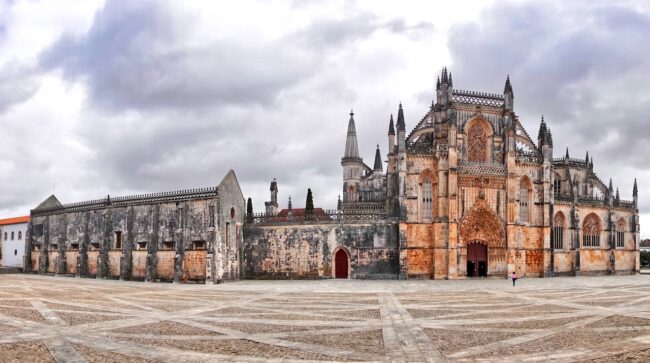
I learned that King João I was the founder of the House of Aviz (Avis) Dynasty, whose motto I believe was, “We try harder.”
It’s hard to find a place in Portugal without a statue or tribute to Henry The Navigator called a “brilliant light of medieval history.” Since 1461 his remains have been at Batalha in the Founder’s Chapel with several of his family members. This bust was created in 2010 to commemorate the 550th year since he died.
When we arrived at 10:30, the place was virtually empty. (I guess everyone was in Sintra.)
In the square stands a statue of Nuo Álvarez Pereira, a strategist in winning the Battle of Aljubarrota. He was also a brother at the Convento di Carmo in Lisbon and was canonized by Pope Benedict XVI in 2009. He now goes by the name of Saint Nuno of Saint Mary.
Walking around the exterior, you got a good feel of how large this place really was.
On each side of the entrance to the Nave of the Church of Santa Maria da Vitória are the apostles.
Once inside, the first thought is, “This church is huge.” It’s more than 260 feet long and more than 100 feet tall. It is quite impressive. as are the stained glass windows near the altar.
For more than 25 years the man who served as architect for the monastery was Mateo Fernandes. As a reward for his efforts, his tomb is located within the church.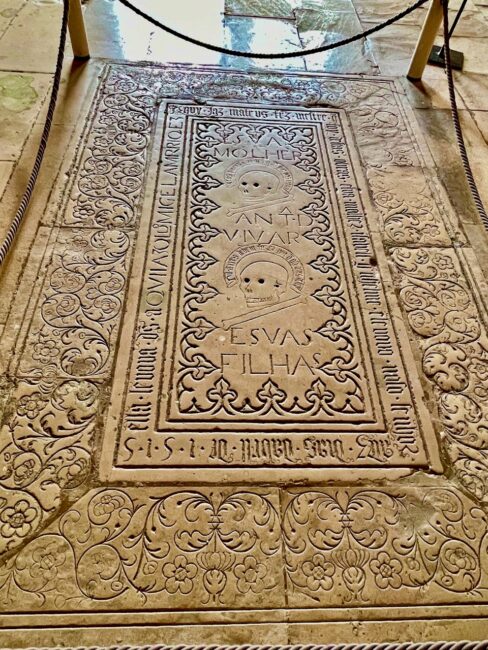
Just off the nave is The Founder’s Chapel, which was built as a family pantheon in 1434 for King João I and the Avis Dynasty. The King and Queen Filipa de Lencastre’s magnificent tombs are located in the center of the chapel where they hold hands for eternity (we get a better view of another royal couple later).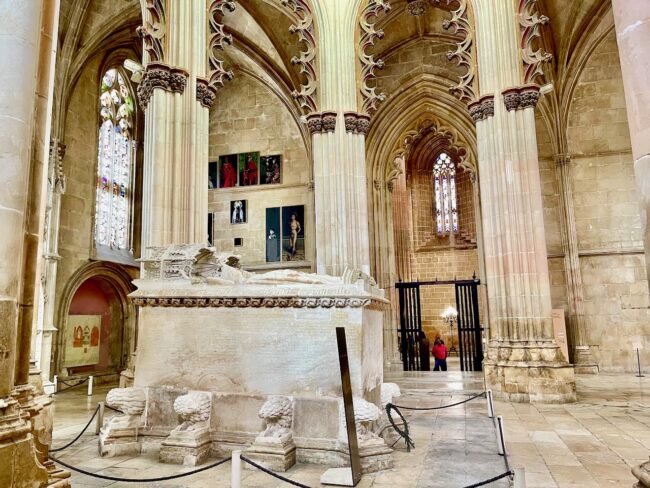
There are, of course, tombs of other royals, but the one everyone gravitates to after the king and queen is the one of Henry The Navigator (on the right). I believe Prince João and his wife, Isabel, are the ones on the left.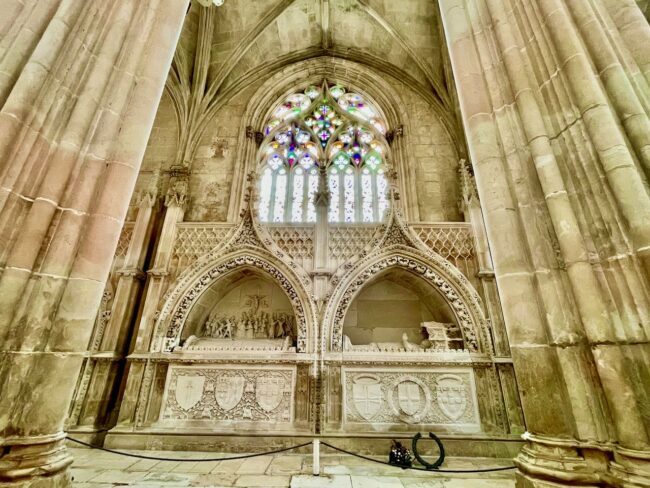
We saw a lot of tombs on this trip.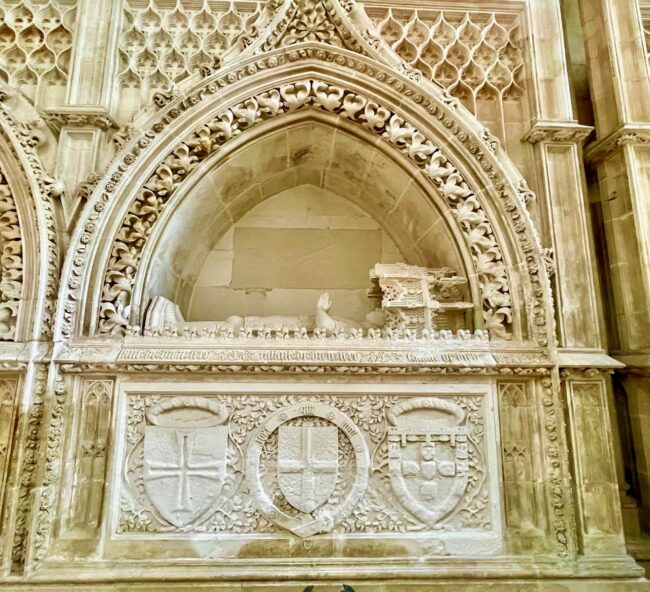
Entering the Chapter House, the first thing I spotted were two soldiers with weapons standing guard.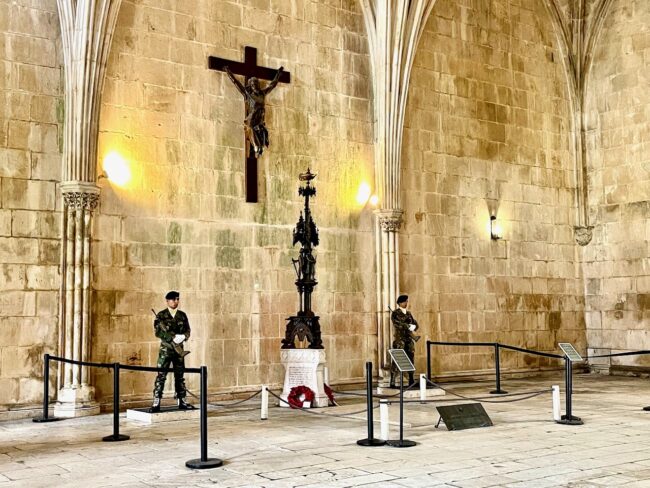
That’s because this room contains The Portuguese Tomb of the Unknown Soldiers of two unknown soldiers who were killed during World War I.
The stained glass window dates to 1508.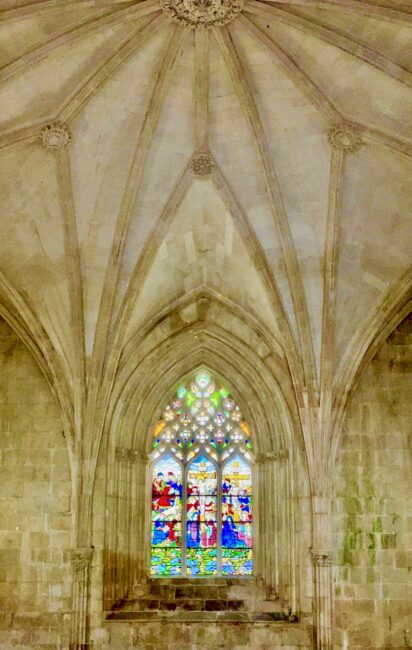
We stepped into The Royal Cloister also known as the Cloister of King João I.
The Basin served as a very important part of the monastery’s hydraulic system. This is also where washing of hands took place before dining (and this was pre-pre-Covid).
It is a beautiful space and even had a ceiling for Tracy to photograph.
Not every part of the monastery had a ceiling, however. We entered the Imperfect or Unfinished Chapels, which began construction in 1334 under King Duarte.
What they don’t have, is a roof in the center. When King Duarte died in 1347 followed by his architect David Huguet a year later, construction was ceased.
During King Manuel’s reign in the early 16th century, the seven funeral chapels were completed. In the 1940s the twin tombs of King Duarte I and Queen Leonor de Aragão were relocated here, with the couple holding hands for the rest of time.
One of the chapels holds the tomb of Prince João, the first-borne son of King Alfonso V. I just don’t know which tomb. By now I was suffering from tomb fatigue.
Finally, we checked out the Unfinished Chapels from the outside.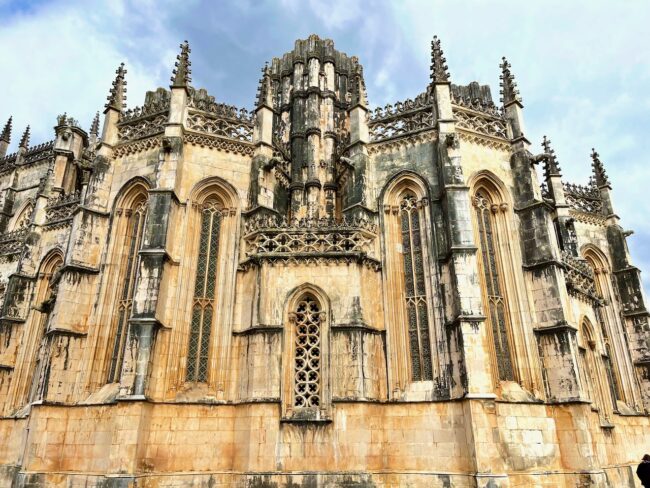
From Batalha, it was a short 15-minute drive to the Castelo de Leiria. Then, in a portent of things to come later in the day, we got completely turned around and drove the low roads and high roads of Leira in search of a parking place. After passing the futbol stadium across the street from the castle, we just decided to park there, not knowing if that was legal, and by this time, not caring.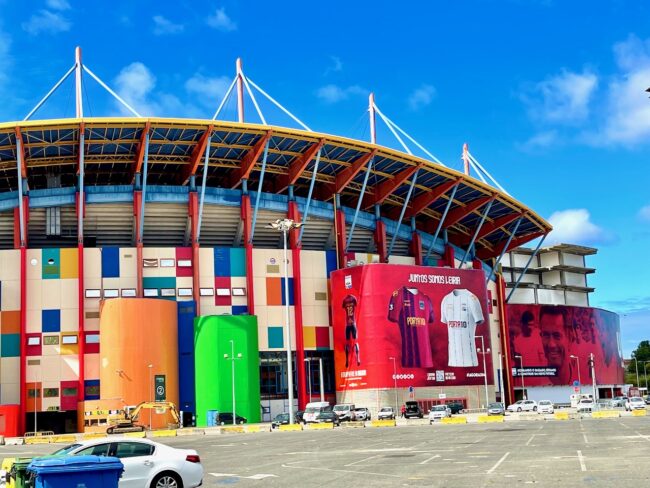
Staring at the castle looming high above us, we were happy that Tracy had (on one of our many passes of the castle) noticed there was a funicular nearby. Our legs shouted out in glee.
These happy tourists headed to the summit.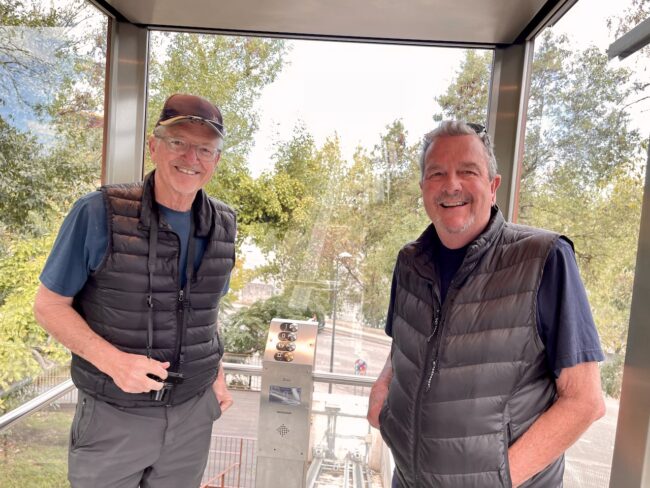
We entered the castle grounds through the Albacara Gateway (I think) ,,, … and confirmed our car and luggage were still there. So far, so good.
… and confirmed our car and luggage were still there. So far, so good.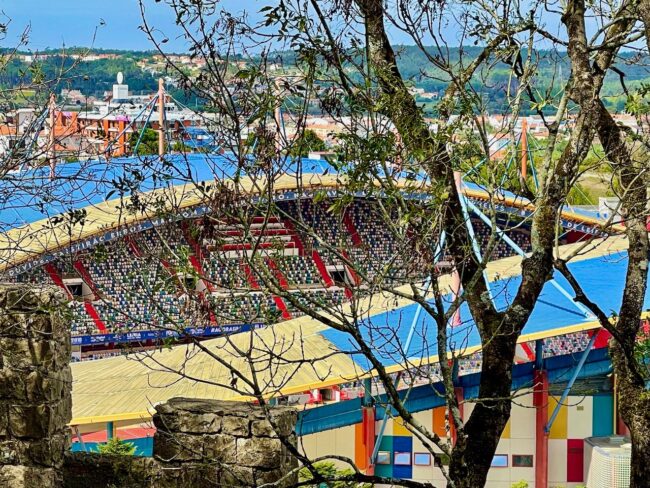
This castle dates to the 12th century, which seemingly was the last time we ate. We knew at this juncture, this would be one of our shorter stops. The site has actually been occupied for about 5,000 years. We took a look at the Torre dos Sinos (Bell’s Tower), which is where hawks used by the royalty for hunting were kept …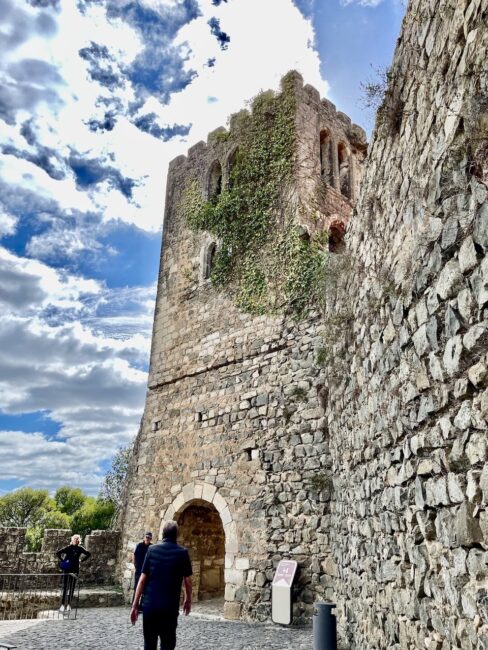
… and started up the steps. I sometimes use Tracy’s shoulders as the rail, which is why she tends to list to one side sometimes.
Soon we found ourselves in the renovated interior of Santa Maria da Pena.
Through a little sleuthing, I believe this is a page from Livre de Chasse (Book of the Hunt) called “the most famous book on hunting ever.” Written in the 1380s by Gaston Phoebus, who was one of the “greatest hunters of his generation.” He died from a stroke “while washing his hands after a bear hunt.” Use that tidbit at your next cocktail party.
There were great views of Leiria and the surrounding countryside from one of the patios (we can never get enough arch photos), but hunger finally won out.
Our car was still in the stadium parking lot, and after checking that nobody had stolen our underwear, we drove into town, which was a lot easier than our first foray into Leiria. There is a popular Portuguese rhyme that says, “Leiria has a river that flows uphill, a tower that does not have a cathedral, a cathedral that does not have a tower, and a High Street that is not straight.” All we needed to find was the local restaurant the castle gatekeeper had recommended.
After walking through a couple of squares … 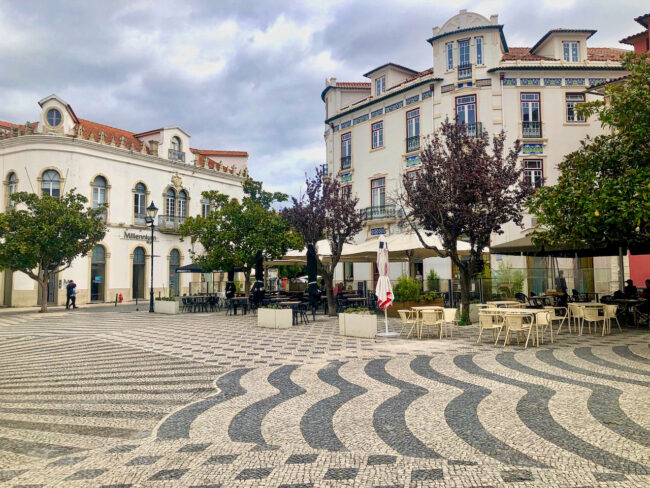
… we found Restaurante Porto Artur. The inside was jammed, and there was only one table left on the patio, which is situated in an alley. This was the first place on the trip where we heard no English spoken. The gatekeeper had said this was definitely where the locals hang out. We could see why. The prices were incredibly inexpensive (lunch specials including soft drink for €8).
Ours was not that inexpensive, but the traditional Portuguese cuisine was very good, from the swordfish to the pork cutlets to my gigantic dish of pork with white beans and rice. It could have been shared by the four of us.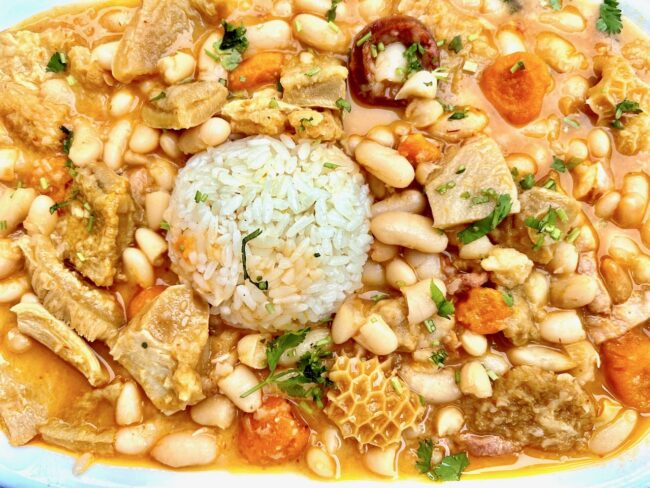
Across the alley was a building that had become a canvas for some colorful street art.
The only downside was our table was also across from a number of garbage cans, so when I say this restaurant had a buzz, it’s not only because it was packed. A few flies aside, however, Porto Artur was a great call when visiting Leiria.
From Leiria it was a little less than an hour to our next two-night stop. Crossing the bridge into Coimbra, our mission was to find Hotel Solar Antigo Luxury Coimbra, which was located very near the university where we’d take a tour the following day. Getting to the hotel was an adventure. The higher we drove, the narrower the streets became, with hairpin turns being the order of the day. At one stop I glanced at my passengers’ faces, who were trying their hardest to conceal the terror that was evident with their looks.
I came perilously close to not making one incredibly sharp turn, and with cars following close behind me, I did not want to cause a jam. Thankfully, I made the turn, but somehow we had missed the hotel and started heading back down to where we started. We made a second drive-thru and once again somehow could not find the hotel. Back down below I pulled to the side of the street to regroup. Tracy pointed and said, “Look, there’s a parking garage. Why don’t we pull in there and Uber to the hotel?” Why not, indeed.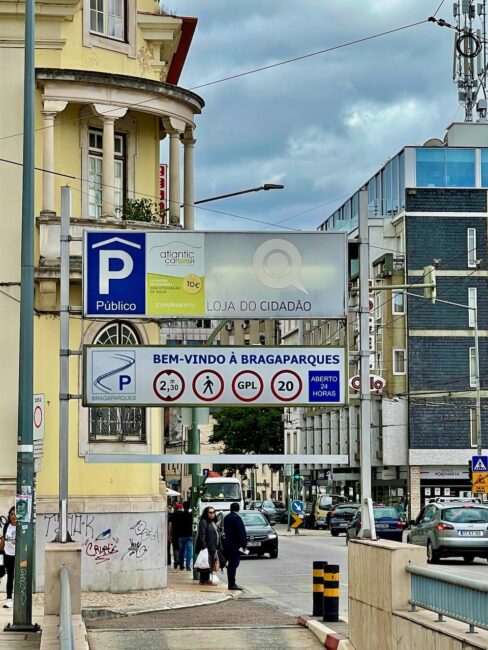
Our Uber driver must have been a retired Grand Prix driver, because before you could say Niki Lauda, we were in front of our hotel. We were greeted by our friendly hostess, and shown to our rooms, which were upstairs (steep … no elevator). The only rooms left when I had emailed earlier in the year were a Deluxe Apartment and a Deluxe Suite. Kim and Mary graciously took the extra flight of stairs to the Deluxe Suite.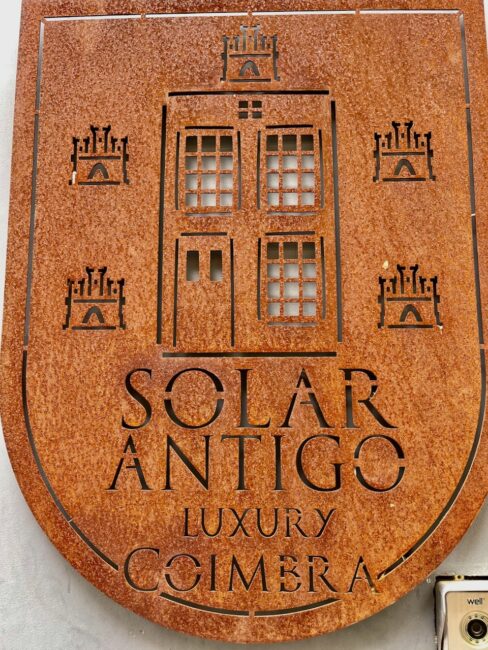
It’s hard to describe our room. First of all, it was huge (more than 600 square feet). It had two bedrooms, and two showers that were cleverly hidden in the bedrooms. Oh, it also had a kitchen. This was bigger than the apartment I rented when I was a disc jockey decades ago. Quirky, but elegant in a strange way.
Kim and Mary’s bed in their room looked like something out of a Hallmark romance movie. The only thing missing was Hugh Hefner’s smoking jacket.
In the early evening, we walked down to town to check out a few things before dinner. We saw where we had made the wrong turn (twice) and enjoyed the views.
Below us at one point was the The Jardim da Manga (aka Claustro da Manga). King João III commissioned this building, one of the first Renaissance architectural buildings in Portugal, in 1528. The cloister with an Arabic architecture feel, is located behind Igreja de Santa Cruz.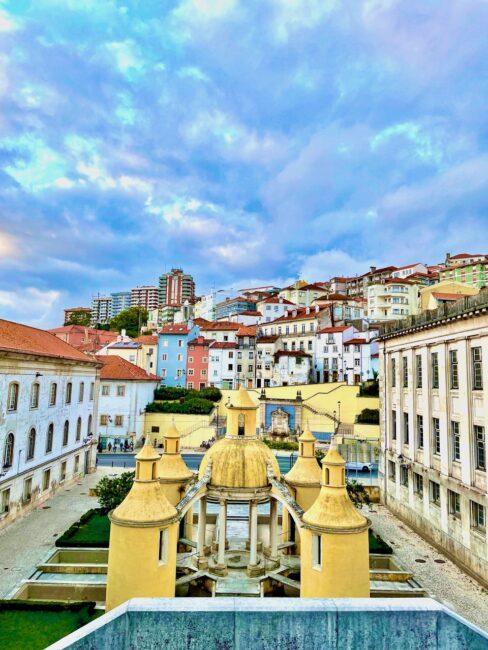
In a few minutes we were down in the Praça 8 de Maio (May 8th Square). It dates back to the 10th century when it had a different name. The square was renamed in honor of a historical event on May 8, 1834, when monarchist’s control of Coimbra were ended by liberal troops who took over the city.
It was a little before 7 p.m. closing time when we ducked into Igreja de Santa Cruz.
It was a lovely church that included an 18th century Baroque pipe organ. Unbeknownst to us, there was so much more to this church that we missed, but fortunately we stopped in again the following day.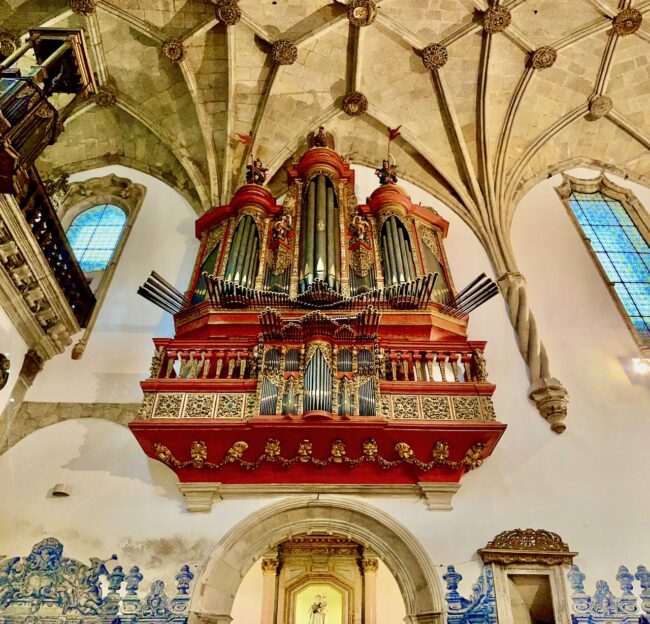
We walked around town scoping out some of the colorful buildings …
… and at about 7:25 we made our way to the highly recommended No Tacho, where we had 7:30 dinner reservations (and no, we did not line up by height).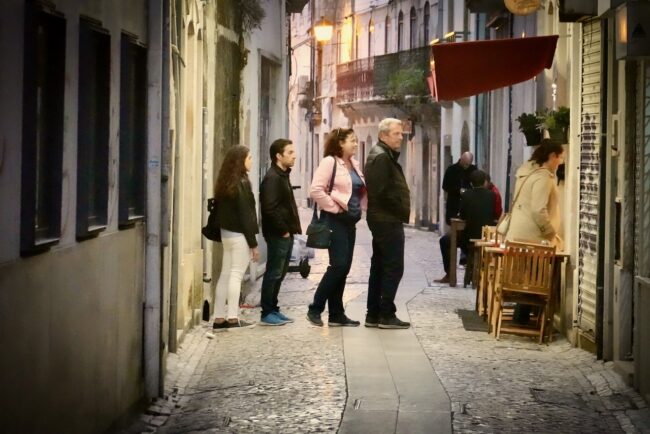
The compact restaurant is super cute, and the food more than lived up to its advanced billing. 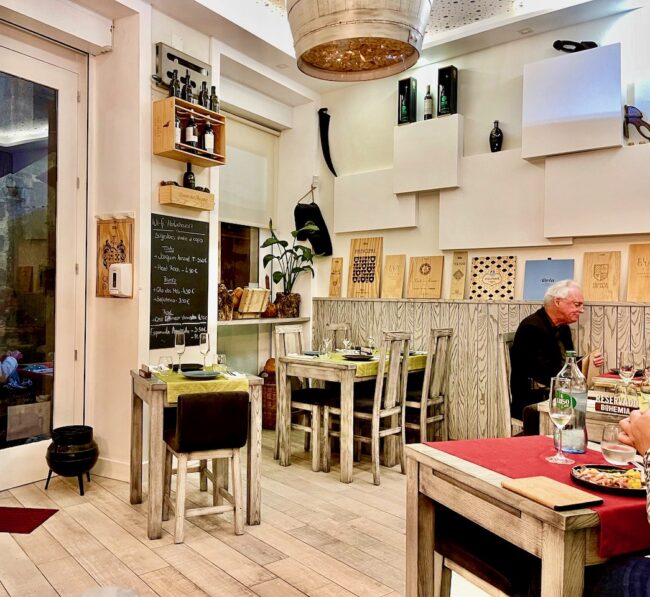
We shared a fantastic charcuterie platter of Portuguese cheeses and meats, along with some of the most tasty fresh fruit I’ve had in a long time. In fact, the fruit we tasted in Portugal at virtually every restaurant had incredibly great flavor.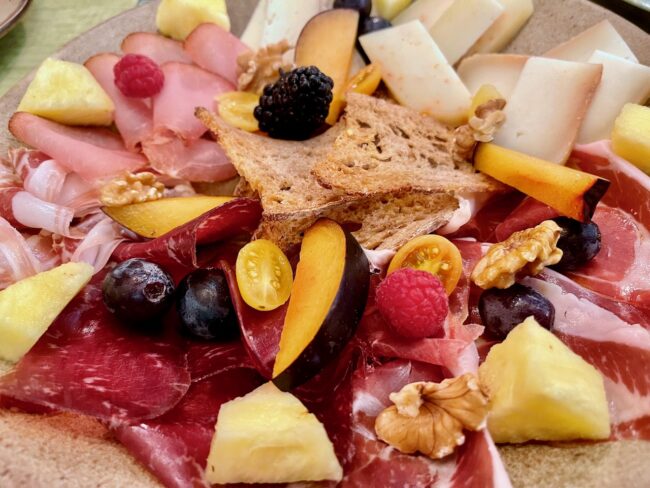
Mary loved her grilled octopus on a parsnip purée with asparagus and carrots.
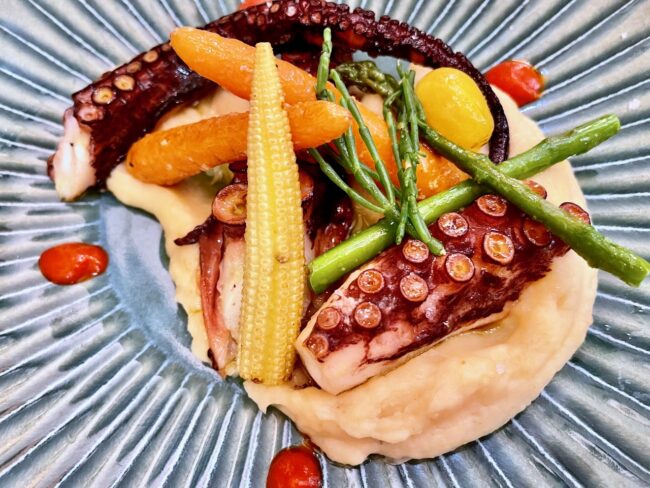 Kim tried a confit codfish with orange, bay leaf and coriander seeds, as well as smashed potatoes with onion purée and fennel.
Kim tried a confit codfish with orange, bay leaf and coriander seeds, as well as smashed potatoes with onion purée and fennel.
My veal tail with vegetables was really good, as was Tracy’s large mixed salad with pineapple, red onion, cucumber and peppers. She likes to get her 5 A Day in one meal.
All this and a good wine by the glass selection (despite all the bottles lining the wall, they only serve by the glass) came to only €57 per couple. Great meal!
We walked off some of the calories only to pack on more with gelato we purchased near the square.
As we strolled along, we passed a number of students in black capes and hats. I thought there might be a Harry Potter convention in town, but Coimbra being a college town, these were students at the University of Coimbra. It is some type of freshman ritual.
Back at the hotel, we settled in for good night’s sleep, however at about 2 a.m. loud singing could be heard coming from all over town. I guess singing is also a tradition for students, however at this hour I surmised that alcohol could be involved. Somehow we managed to get back to sleep, and that’s good because tomorrow would be quite the busy one.
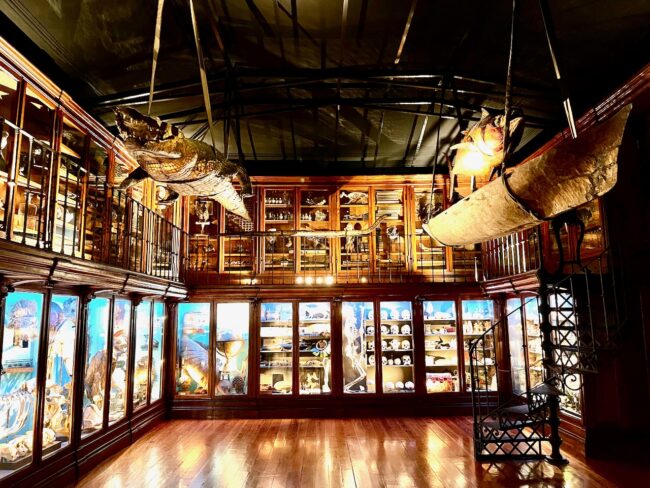 We had 10 a.m. reservations for a tour at the University of Coimbra, which would include a visit to one of the most significant archival libraries in the world (and a gorgeous one), a 16th century chapel, a historic Royal palace, the Cabinets of Curiosities (and curious they were) plus a chemical laboratory. We’d also hit an art gallery located in a former Bishop’s Palace and Coimbra’s “New” Cathedral.
We had 10 a.m. reservations for a tour at the University of Coimbra, which would include a visit to one of the most significant archival libraries in the world (and a gorgeous one), a 16th century chapel, a historic Royal palace, the Cabinets of Curiosities (and curious they were) plus a chemical laboratory. We’d also hit an art gallery located in a former Bishop’s Palace and Coimbra’s “New” Cathedral.
After lunch we’d walk through Coimbra’s famed tower and revisit Igreja de Santa Cruz, which we found out much to our surprise is also a monastery along with the Pantheon for the first kings of Portugal. What’s a day without a tomb or two? Finally, we’d dine in a ceramics factory where we literally ate inside a chimney.
Chapter Thirteen: Combing Coimbra
Day Thirteen: Agile Breakfast Servers, That First Step Is A Doozy, What Tour?, Bookin’ It, Checking In With Michael, A Curious Room, Lab Rats, Not Manny Machado, Lunch At The Museum, The Giant Gin & Tonic, Tower of Power, Surprise Monastery, That’s Our Parking Lot, Dinner At Pottery Barn and Open The Flue

